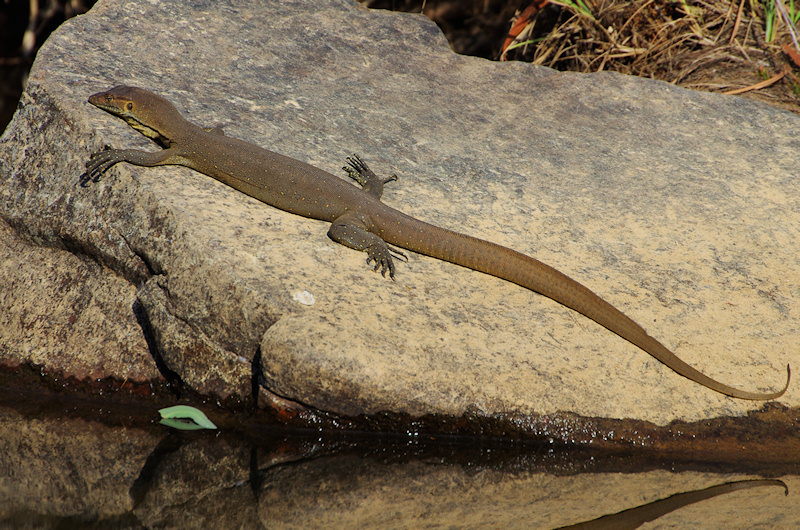Mertens' water monitor
Mertens- Wasserwaran ( Varanus mertensi )
The Mertens- Wasserwaran ( Varanus mertensi ) or Australian Wasserwaran is a native to Australia type of monitor lizards ( Varanus ). He is probably the strongest linked to the water monitor lizard.
- 6.1 Notes and references
Features
The Mertens- Wasserwaran reached a total length of up to 1.3 m at a head-body length of 48 cm. Typical of adult specimens are total lengths of only a little over 1 m. The nostrils are strongly shifted dorsally ( = above), whereby the Mertens Wasserwaran can breathe in the water while he only has to lift small parts of the snout from the water. The tail is about 1.5 times as long as head and body, has a very pronounced keel on the upper side and is compressed as a rudder tail with strong lateral. The scales of Mertens- Wasserwaran are very smooth and can be especially wet specimens appear to be very slippery.
The body top is drawn in black to brown or gray with scattered small yellowish points. The underside is yellow to cream-colored, and speckled light gray on the neck and chest.
Distribution and habitat
The species inhabits the northern Australia from Kimberley in the east to the west of the Cape York Peninsula. Their stocks are tied to permanent waters, such as rivers, lakes and permanent billabongs.
Way of life
General
Like all dragons is also the Mertens Wasserwaran diurnal. The night the animals spend in building that just transitions are applied from 0.3 to 3.2 m in length with an enlarged chamber at the end of the embankment as, and whose inputs are often only slightly above the water surface. The Build to leave about 8 clock in the morning, used in disorders as a refuge and return to about 16 clock the dragons back to the night in the construction of a. Occasionally the monitor lizards sleep in the water, in hollow tree trunks or on branches hanging over the water. In case of faults, the monitor lizards emerge from. Unlike many other Australian lizards Mertens Wasserwaran normally holds no seasonal rest period and remains active throughout the year; this is related to the year-round availability of food to permanent waters. Only in rare cases, the Mertens- water monitors buried to a rest period in the dry season from May to October. The Mertens- Wasserwaran is a little more circumspect thermoregulator, but usually keeps his body temperature hovering around 34 ° C.
Nutrition
The Mertens- Wasserwaran searches lambent both on land and in the water for prey. In shallow water, he can carry his tail fish towards its mouth, and in deep water it runs at the base. The food range includes aquatic and living on the banks of prey such as crustaceans, beetles, fish, spiders, various insects, Aphipoden, frogs, reptile eggs, birds and small mammals. They are known to dig up buried turtle eggs.
Reproduction
The male Mertens- water monitors to September spermatogenetisch in the dry season of July and store their sperm to the period from December to March. In this period of the rainy season, the vitellogenesis of the females fall, and thus the mating season. The early production of sperm the Mertens Wasserwaran is always the earliest possible moment ready to mate. Even when Mertens Wasserwaran typical Comment fights between males occur, the fight for females. The nests are placed in the early dry season and include 3-14 eggs. The young hatch then during the height of the next rainy season, when the highest level of food is available.
System
The first description was in 1951 by the herpetologists Ludwig Glauert. Type locality is Moola Bulla, Western Australia (18 ° 12 'S, 127 ° 30'E ). The specific epithet honors the German herpetologist Robert Mertens (1894-1975), who wrote in 1942 a major monograph on monitor lizards. Within the genus Varanus Varanus mertensi is assigned based on its Hemipenisstruktur the subgenus Varanus. DNA analyzes suggest a particularly close relationship with Varanus giganteus and Varanus spenceri, and confirm the classification based on the hemipenis morphology.
Endangering
Like other Australian lizards is the Mertens Wasserwaran by the introduced in Australia ( neozoische ) Agakröte (Bufo marinus ) at risk. They die when they take the skin of toxins by attempting to eat the toad. With a population at the Daly River ( Northern Territory ) the stock decline one year after the arrival of cane toads was estimated in comparison to the population before the arrival of cane toads to 92 %.
Swell
- Christian K. (2004): Varanus mertensi. In: ER Pianka & DR King ( ed.): Varanoid Lizards of the World. Indiana University Press, Bloomington & Indianapolis. ISBN 0-253-34366-6










